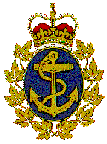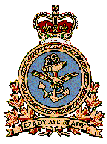Commend Naval Men On Smart Capture of Speedy German Ship
Commander Beard and Officers of H.M.C.S. Prince Robert
Guests of Honor of Canadian Club – Story of Naval Strategy Told
Unknown ~ Likely before October 10, 1940
How the element of surprise delivered the German freighter Weser into
the hands of the navy, represented by the H.M.C.S. Prince Robert. Off the
Mexican port of Manzanillo, was related by Commander C. T. Beard, R.C.N.,
captain of the armed merchantman which brought the Nazi prize to a British
Columbia port, when he addressed the Men’s Canadian Club at luncheon in
the Empress Hotel yesterday.
“The Germans really aren’t as clever as they are given credit
for,” Commander Beard remarked, describing how the unsuspecting captain
of the Weser brought his ship out of port under cover of darkness, to be
captured without resistance by the waiting Prince Robert, which had been
playing a watching game off the coast for seven days.
Commander Beard, his first lieutenant, Lieutenant-Commander G.
B. Hope, who led the boarding party, and A. F. Mathieson, R.C.N.R., warrant
engineer, who took charge of the Weser’s engine-room, were the club’s guests
of honor at a special luncheon to mark the Prince Robert’s exploit. Other
guests included Most Rev. J.C. Cody, D.D., Bishop of Victoria; Commodore
W. J. R. Beach, R.C.N., senior naval officer on the Pacific Coast; Col.
H. C. Greer, second in command at Work Point; Air Commodore A. Earl Godfrey,
A.O.C., Western Air Command; R. W. Mayhew, M.P., and Hon. Dr. K. C. MacDonald,
Minister of Agriculture.
HIS HONOR”S PRAISE
R.A. Wootton, new president of the club, read a message from
Hon. E. W. Hamber, Lieutenant-Governor, expressing His Honor’s regret
that engagements in Vancouver prevented him accepting the club’s invitation
to be present, and asking that his congratulations should be tendered to
Commander Beard and the officers and crew of the Prince Robert. His Honor
referred to the capture of the Weser as a magnificent exploit that had
added honor to the already splendid record of the Royal Canadian Navy.
Commander Beard was greeted with the singing of “He’s a Jolly
Good Fellow” and a round of cheers after he had been introduced by Mr Wootton.
He spoke of the capture of the Weser as a small detail in the war, and
expressed a hope that when the Prince Robert went out again she would give
the club something of which to be really proud.
“We went out to do a job, prepared for it. We were lucky; we didn’t
know the enemy would fit into the scheme quite as well as he did,” was
the way the speaker summed up the capture.
ARMED MERCHANTMAN
Describing the function of the navy in wartime as that of keeping the
trade routes open for the Empire’s own trade, and denying them to the enemy,
Commander Beard explained that armed merchantmen had been brought into
the picture because they were cheaper to build and were admirably suited
to perform duties such as that done by the Prince Robert. These merchantmen
were able to stay at sea for long periods, and were sufficiently armed
to be able to tackle enemy raiders.
The Prince Robert had left here in a hurry, and it was that hurried
departure that presented far more difficulties than the actual capture
of the Weser, Commander Beard said. It was essential that the ship should
get out without anyone knowing her movements.
To preserve that secrecy, no wireless signals were made by the
Robert while she was at sea. However, it appeared as if that secrecy had
been broken when, not far out, the naval vessel ran into a ship which was
at first thought to be the one for which she was looking and which radioed
a description of the occurrence. Later the Robert passed another ship bound
for Vancouver, and stopped her, Commander Beard wishing to transfer important
mail to her. The skipper of that ship immediately made signals that he
was being captured by an enemy raider, after dumping all his confidential
papers overboard.
SURPRISE SPRUNG
So, by the time the Prince Robert reached her objective, there was
little hope that her presence remained unknown, Commander Beard continued.
However, it turned out that the captain of the Weser was completely unaware
that there was a naval ship in the vicinity, and the engineer was in his
cabin drinking cognac to celebrate a safe departure when the Weser was
stopped and boarded.
Commander Beard described the strategy employed in the week of
waiting and in surprising the Nazi ship when she eventually left the security
of the Mexican port, giving the fullest credit to Lieutenant-Commander
Hope, whose quick and well-planned actions had prevented the scuttling
of the prize, and to Mr. Mathieson, who had been given the difficult and
dangerous charge of her engine-room.
Lieutenant-Commander Hope told of the actions of the boarding
party, mentioning that the Weser’s crew had made preparations to set the
ship on fire if necessary, but had been unable to give effect to their
plan. The trip north aboard the Weser had been uneventful, but every member
of the German engine-room crew had a guard placed over him so that no monkey
wrenches could be thrown into the works.
Lieutenant-Commander Hope added that the Weser, with her 10,000
ton cargo capacity and speed of seventeen or eighteen knots, would prove
a most useful ship to Canada.



